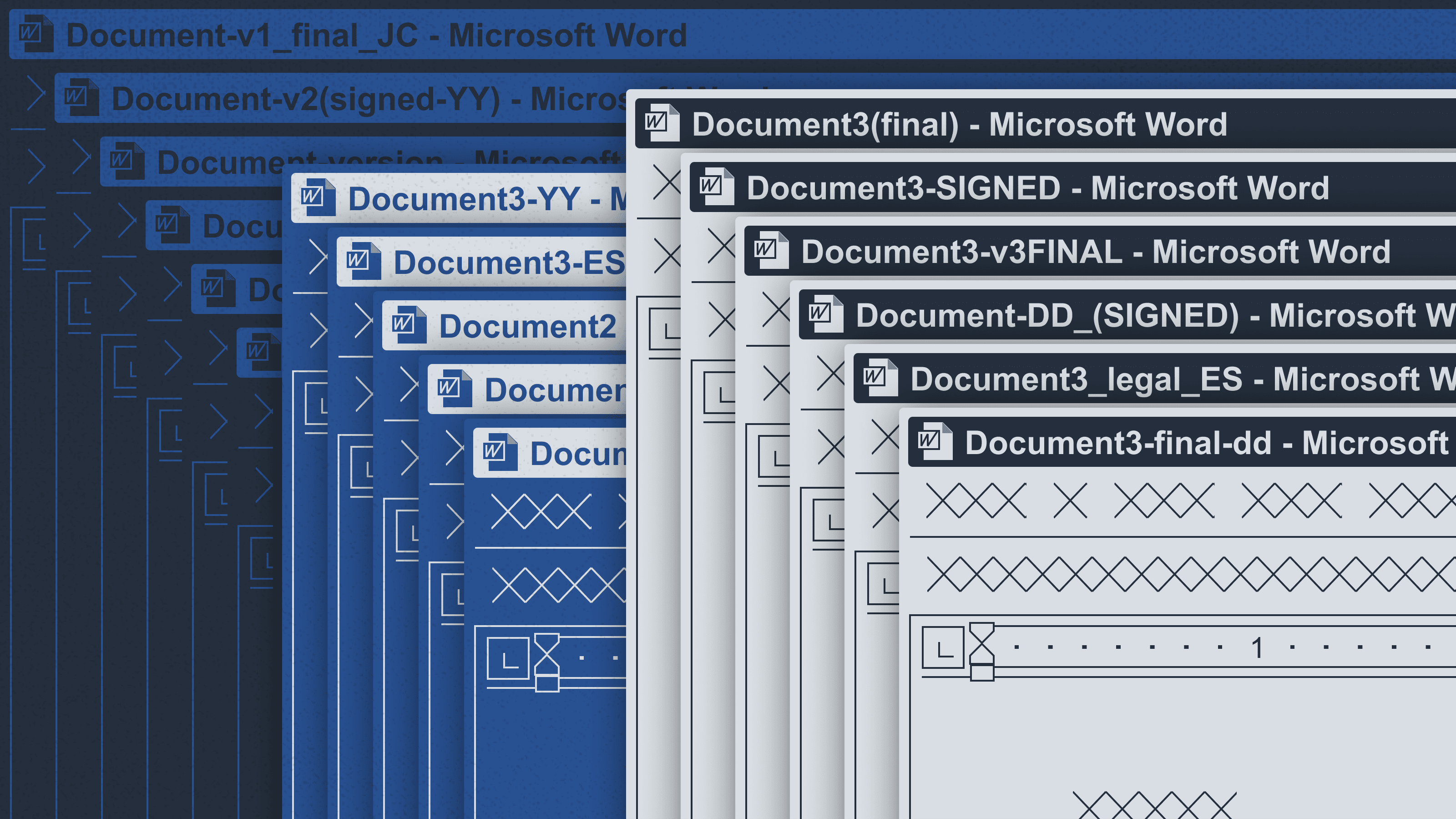When I was fundraising for Outlaw’s Seed round in 2018, one [now-current] investor said to me, “Wow, you must really hate Microsoft Word!”
I laughed, and then explained that actually no, I didn’t; and in fact I have great admiration for Word – and for Microsoft on the whole. It’s easy to take aim at the market leader in any category, and when you’re pitching a new innovative startup, you have little else to work with than the better mousetrap angle. But taking a step back, as a coder first & foremost, I feel real deference toward any piece of software that has not only survived, but stayed number one for twenty-five years. That’s like, five generations in tech. Seriously: respect.
To be clear, when it comes to contracts, Microsoft Word is not ultimately the right tool for the job. It’s horizontal software meant for general-purpose word processing, so when utilized to handle the more demanding needs of vertical-specific scenarios like contracting (structured data, variables, conditional clauses, advanced permission management, etc), it falls woefully short. That’s not exactly Word’s fault, because it was never designed to handle those things in the first place. But it does create a market opportunity for Outlaw and others: at the very least, just about any of us here can help to fill in some these gaps… and a select few aim higher to offer transformational change.
Understandably though, many customers want the best of both worlds: they want the benefits of seamless UX and smooth deal flow from a modern, real-time, collaborative platform like Outlaw, and when it comes to more in-depth document editing and redlining, they want to work in an environment that they (and, perhaps more importantly, their counterparties) are familiar with, without needing to learn anything new. In other words, they want to keep using Microsoft Word.
As a rule, I never say impossible… but this one is… challenging. There are actually two equally weighty challenges here: a technological one, and a behavioral one.
The tech side is a little more cut and dried. The only software in the world that can visualize and edit Microsoft Word documents with 100% reliability is Microsoft Word. Period, full stop.
Yes, .docx is technically an “open format” based on XML, but the specification is hundreds of pages long, with 25 years’ worth of inconsistencies, nuances and gotchas baked in, making it dizzyingly complicated and costly for anyone else to attempt a comprehensive implementation. Frankly, kudos to Microsoft for finding a legal way to maintain this monopoly! Even Google, who bit the bullet and finally launched native editing recently, still much prefers users to convert the files to Google Docs format… and that took them about 15 years and hundreds of engineers. I met a bunch of them when I worked there prior to founding Outlaw.
When it comes to contracts, the “100% reliability” piece is very, very important. It’s worthless if it only works most of the time – even if most is 99% – because that 1% represents unacceptable risk from a legal perspective. If, in certain cases, changes are lost, or reverted, or metadata is stripped, or certain people lose access, or certain elements (like tables or images in a certain format) are stripped out from display or displayed differently… no lawyer in his/her right mind would agree to using that to negotiate a contract.
These are the inconsistencies that start to crop up when you try to build a complete, native docx editor. I know, because Outlaw started down this path a few years ago and quickly discovered that while it worked most of the time… most is not good enough for contracts.
Some other platforms claim to have full-fledged native docx editing, but when you look closely at videos, screenshots and product demos, it quickly becomes apparent that that’s not Microsoft Word. It’s a barebones, custom-built version of an editor with partial implementation of the docx spec that works (hopefully) most of the time.
But actually, the level of fidelity of these competing half-baked docx editors is somewhat moot, because this is where the behavioral side of the problem comes into play. In the real world, contract negotiations adhere to Las Vegas rules: What happens in Microsoft Word stays in Microsoft Word.
Think about it. Someone sends you an email with a [ServicesAgreement.docx] attachment, and says, “Here’s the draft contract, please take a look and mark it up if you have any proposed changes.”
Are you going upload that into your new-fangled online realtime collaborative editor, work on it there (crossing your fingers that nothing gets accidentally stripped out or reformatted in the process), and then re-export a fresh docx to send back?
HELL. NO.
Not if you want any prayer of actually getting to a signed agreement. You (or your counsel) are going to pop open Microsoft Word, turn on Track Changes, and dig in. And when you’re done, you’re going to respond in kind: an email with a docx attachment. And that process is going to ping pong back and forth until someone (hopefully) says, “Great, we’re ready to sign, so I’ve uploaded it to DocuSign for execution – you’ll receive a link shortly.”
An important distinction here is that docx generation is not the same as editing an existing docx. Outlaw (and others) can easily generate and export flawless initial draft docx files for the traditional deal flow described above. We have quite a few customers using the platform just for the dynamic, templated contract generation capabilities (this is our Draft module) and getting a lot of value from that.
And, for contract scenarios where there is interest in a fully modernized contract process, Outlaw’s Flow module enables end-to-end collaborative dealmaking without ever touching Microsoft Word, or DocuSign either for that matter.
But that’s not what we’re talking about here. We’re not talking about revolutionary change in which a customer adopts the full future in all its real-time, cloud-based glory; we’re talking about evolutionary change, building a bridge between entrenched traditional offline contract processes and an eventual docx-free future, one step at a time. So again, the challenging – but incredibly widespread – scenario we’re examining here, is one in which customers want to start natively on-platform, then export a docx and send to counterparty for redlining (in Word)… and then still, somehow, continue to collaborate on-platform.
Keeping in mind our two axioms from above…
- The only software in the world that can visualize and edit Microsoft Word documents with 100% reliability is Microsoft Word.
- What happens in Microsoft Word stays in Microsoft Word.
…the real question at hand becomes this:
Once a contract is in docx form, how can external software still help?
This is where we can take a page out of the traditional CLM playbook. In a nutshell: treat the docx as a black box, and make it as easy as possible to attach metadata to it and store it somewhere central.
This is exactly what Outlaw (and others) offer today for contracts that go (or start) off-platform. Contract admins can take each docx version file as the lawyers ping-pong back and forth via email through redlining, and upload/tag/associate them all with the same overall contract object. And once it’s ready for signing, that can be done on Outlaw as well, or via another eSigning service (DocuSign etc) and then the final executed pdf can be uploaded to Outlaw.
All of that works, today, and creates a lot of value for many customers. And it beats the pants off a shared folder on a network drive, that’s for sure. But we can still do better.
Outlaw will soon be developing a Microsoft Word Add-In, available to all paying customers. This will enable our customers to have a one-click “sync” — making it even easier to keep the version management and contract repository on Outlaw fully faithful to an underlying offline deal process, while also continuing to seamlessly leverage Outlaw’s powerful collaboration features (including my personal favorite, Checkpoints)… all while working from inside Microsoft Word.
Because Microsoft Word hasn’t maintained its supreme reign without embracing a third axiom in modern software development:
If you can’t beat ’em, join extend ’em.



